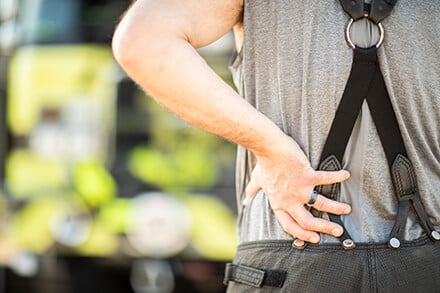Back Injuries and Pain
Individual treatment for your back pain

Back pain is a very common medical condition. Most adults have pain in the upper, middle or lower part of the back at least once in their lifetime and it can vary in discomfort or pain. It is also the leading cause of disability worldwide.
Injuries, overuse of your back muscles, issues with your spine and other conditions can cause back pain. Select Physical Therapy provides customized care for patients experiencing back pain, including conditions such as:
- Back sprain/strain
- Herniated disc
- Lumbar radiculopathy (nerve dysfunction)
- Sacroiliitis (an inflammation of one or both of your sacroiliac joints, where the lower spine and pelvis connect)
- Spondylolisthesis (slipped vertebrae) and spondylolysis (stress fracture of the spine)
Our experienced team of therapists will work with you to identify the source of your pain and develop a treatment plan based on the pain and diagnosis to get you on the road to recovery.
Back injuries we treat
-
A back sprain happens when you stretch or injure a ligament or tendon in your back. Ligaments are bands of tissue that connect bones at the joint. Tendons are tough bands of tissue that connect muscle to bone.
When you suffer a back sprain or strain, you may feel a pop or tear. Other times, your symptoms may include:
- Decreased range of motion, making it difficult to walk, bend forward or stand straight
- Limited function
- Muscle cramping or spasms
- Pain
Treatment for your back sprain/strain will be determined once you are evaluated by a physical therapist and your overall goals are shared.
-
A herniated disc is a problem with one of the discs or rubbery cushions between the vertebrae (the bones that make up your spine).
A herniated disc can irritate nearby nerves. In some cases, this causes very little or no discomfort. In other cases, this condition can cause a variety of symptoms. Symptoms of a herniated disc can include:
- Difficulty getting up from a sitting position
- Inability to stand up straight
- Limping
- Numbness or tingling
- Pain in your buttock and legs, including your calf, foot and thigh
- Weakness in your back
You should seek medical attention if you experience any of these symptoms. In most cases, our physical therapists can treat herniated discs. A physical therapist treats the symptoms of a herniated disc. Your treatment plan will be specific to your needs and goals.
-
Lumbar radiculopathy refers to a pinched nerve or inflammation in the spine. Radiculopathy can be caused by an injury, or it may occur for no obvious reason. Your risk for radiculopathy increases as you get older and a family history of degenerative bone conditions.
Symptoms from lumbar radiculopathy are typically worse after long periods of sitting and standing. These symptoms may include:
- Numbness or weakness in the leg and foot
- Pain that begins in the back and moves to the foot
- Tingling in the legs
Your physical therapist will create a plan of care based on your specific diagnosis and overall goals.
-
Sacroiliitis is the inflammation of one or both of your sacroiliac joints, located where your lower spine and pelvis connect.
There are many causes of sacroiliac pain, including injury, arthritis and pregnancy. In rare cases, an infection in the joints can cause sacroiliitis. Symptoms of sacroiliitis may include:
- Difficulty walking, standing or sitting for prolonged periods of time
- Muscle tightness and tenderness in the hips or buttocks
- Pain that is worse when standing and walking and then eases when sitting or lying down
- Pain that radiates down to the knee
- Sharp, stabbing or dull pain in the pelvis or low back area, groin or tailbone
Your physical therapist will create a plan of care specific to your diagnosis and overall goals.
-
Spondylolisthesis and spondylolysis are often described together because the symptoms, common ages of patients with these conditions and treatment are very similar.
- Spondylolisthesis occurs when one vertebra (a bone of the spinal column) slips over the vertebra beneath it
- Spondylolysis is a stress fracture in the lumbar spine
There are many causes of spondylolisthesis and spondylolysis, including genetics or injury to the vertebra. Both conditions are very common in children and adolescents who participate in sports that require heavy lifting or repeated backward bending or twisting of the back, such as football, hockey, gymnastics and dance.
Symptoms of spondylolisthesis and spondylolysis can include:
- Lower back pain
- Muscle tightness or stiffness
- Pain in the buttocks
- Pain radiating down the legs
Your physical therapist will create a plan of care specific to your diagnosis and overall goals.

